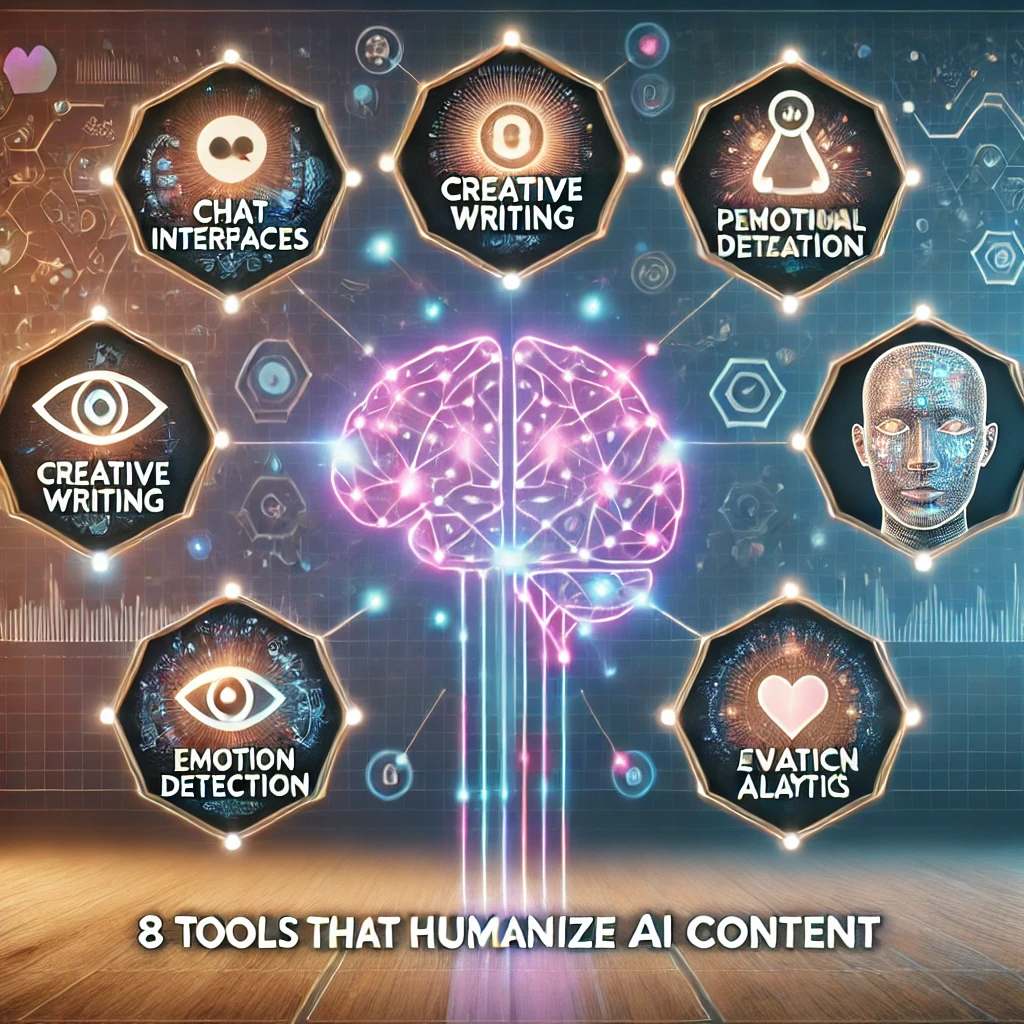
Salesforce OmniStudio Integration Procedure are powerful tools designed to help organizations streamline and automate their business processes by integrating with various external systems. This guide will provide you with a detailed understanding of Integration Procedures, including their key features, building elements, and best practices.
Introduction
Salesforce OmniStudio Integration Procedure are server-side processes that enable complex data transformations and seamless integration with external systems. These procedures allow businesses to orchestrate multiple actions in a single transaction, ensuring data consistency and improving operational efficiency.
Key Features
- Declarative Configuration: Build integration processes using a user-friendly interface without needing extensive coding knowledge.
- Reusability: Create reusable integration procedures that can be used across multiple applications and business processes.
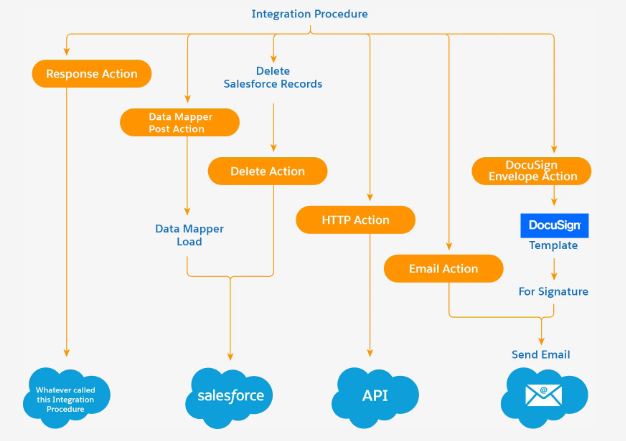
Integration Procedures serve as data sources for multiple technologies
- Performance Optimization: Execute complex data transformations and integrations efficiently, reducing API callouts and processing time.
- Error Handling: Robust error handling mechanisms to manage exceptions and ensure data integrity.
- Security: Leverage Salesforce’s security model to ensure data protection and compliance with industry standards.
How to Create an Integration Procedure
-
Sign up for Omnistudio/ Vlocity Developer Edition:
Here’s how to request one if this is your first time reading an OmniStudio content: Sign up for a special Developer Edition org.
- Navigate to OmniStudio/Vlocity Integration Procedures:
- Go to the OmniStudio application in Salesforce.
Select “Integration Procedures” from the available options or search in App launcher.
Integration Procedure
- Create a New Integration Procedure: Click on the “New” button to create a new Integration Procedure. Provide a name and description for your Integration Procedure.
- Add Elements to the Procedure: Use the drag-and-drop interface to add DataRaptors, HTTP Actions, Remote Actions, Loop Blocks, and Conditional Blocks. Configure each element with the necessary parameters and logic to meet your business requirements.
- Define the Response Structure: Add a Response Action to specify the data returned by the Integration Procedure. Map the output fields to ensure the correct data is sent to the calling service.
- Test and Activate: Test the Integration Procedure to ensure it works as expected.
Activate the Integration Procedure to make it available for use in your applications.
Build Elements
- DataRaptor/ Data Mapper: A tool to extract, transform, and load data within Integration Procedures.
- HTTP Action: Perform HTTP callouts to external systems, enabling real-time data synchronization.
- Remote Action: Call Apex classes or other Salesforce services to perform complex logic or data manipulation.
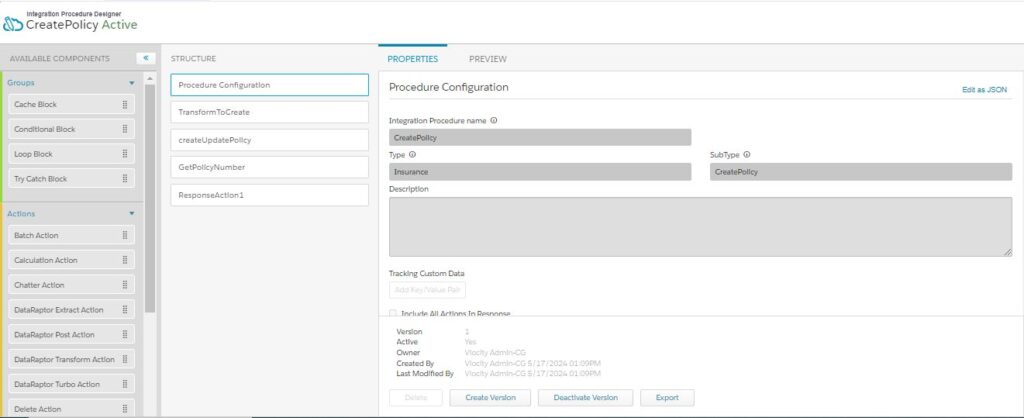
IP Configuration
- Loop Block: Iterate over a collection of records to perform actions on each record individually.
- Conditional Block: Execute actions based on specific conditions, providing flexibility in processing logic.
- Response Action: Define the response structure returned by the Integration Procedure, ensuring the right data is delivered to the calling service.
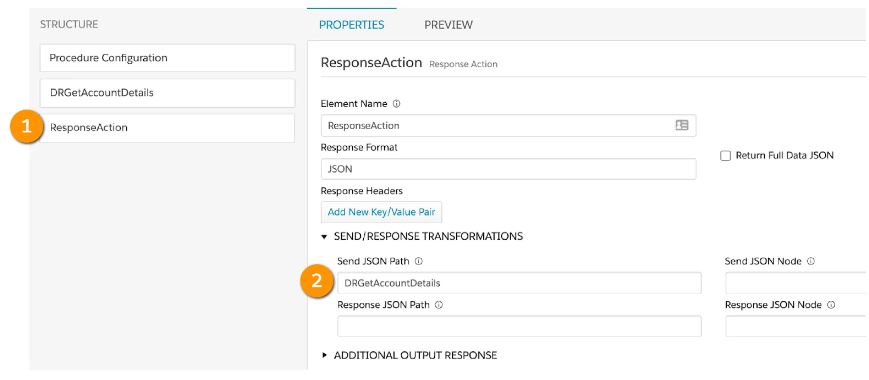
Configure the Response Action (1) to tell the Integration Procedure what data to send back. To trim the data and return only what the you needs, enter previous element name in the Send JSON Path (2) field.
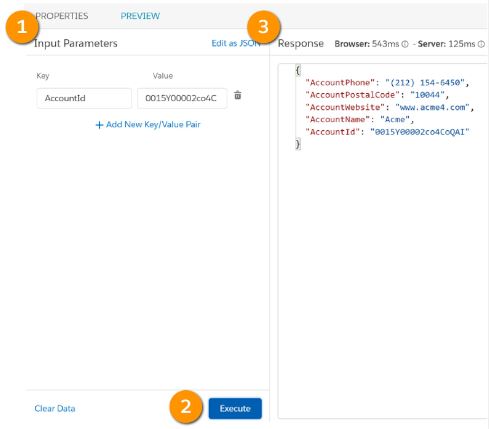
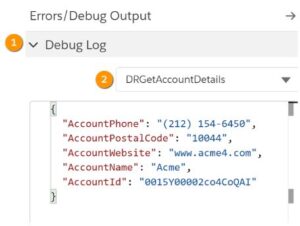 On the Integration Procedure’s Preview tab, enter a Key/Value pair in the Input Parameters panel (1) such as AccountId for the Key and an Account’s RecordId for the Value.
On the Integration Procedure’s Preview tab, enter a Key/Value pair in the Input Parameters panel (1) such as AccountId for the Key and an Account’s RecordId for the Value.
Click Execute (2) to run the Integration Procedure. The Response pane (3) returns results to confirm it is extracting data correctly.
In the Errors/Debug Output Debug Log (1), which helps you to work through and identify any issues with the output and the input for each element in the Integration Procedure. To ensure the Data Mapper is connected to the Integration Procedure, select DRGetAccountDetails (2) and confirm that the Account information displays.
Best Practices
- Modular Design: Break down complex processes into smaller, reusable Integration Procedures to simplify maintenance and enhance reusability.
- Error Handling: Implement robust error handling to manage exceptions gracefully and maintain data integrity.
- Performance Optimization: Use efficient data transformation and integration techniques to minimize API callouts and reduce processing time.
- Documentation: Document each Integration Procedure thoroughly to provide clarity on its functionality and usage.
- Security: Ensure that your Integration Procedures adhere to Salesforce’s security best practices, protecting sensitive data and complying with industry regulations.
Benefits
Salesforce recommends using Integration Procedures as much as possible as a data source. Why? Because they have a streamlined structure that’s efficient and consistent. They’re adaptable to use with all your data sources and easy to navigate.
But that’s not all—they give developers a lot more control over the data going back and forth and:
- Provide optimal flexibility.
- Make implementations easier.
- Greatly improve the performance of FlexCards and OmniScripts.
Replacing Apex classes with Integration Procedures has several perks. For example, Integration Procedures:
- Are much easier to maintain and update.
- Take up to 97% less development time.
Conclusion
OmniStudio Integration Procedures are essential tools for automating and optimizing business processes through seamless data integration and transformation. By understanding their key features, elements, and best practices, you can create efficient and reliable integration solutions that enhance your organization’s operational efficiency and data consistency.
Whether you’re a seasoned Salesforce developer or a business analyst, mastering Integration Procedures will empower you to deliver robust and scalable integration solutions, driving business success in today’s competitive landscape.
Related Posts:
- Supercharge Customer Journeys with Salesforce OmniStudio
- FlexCards in Salesforce OmniStudio: A Beginner’s Guide
- Mastering Salesforce OmniScript: A Comprehensive Guide to Streamlined Workflows
- Seamless Data Integration with Salesforce OmniStudio DataRaptor


